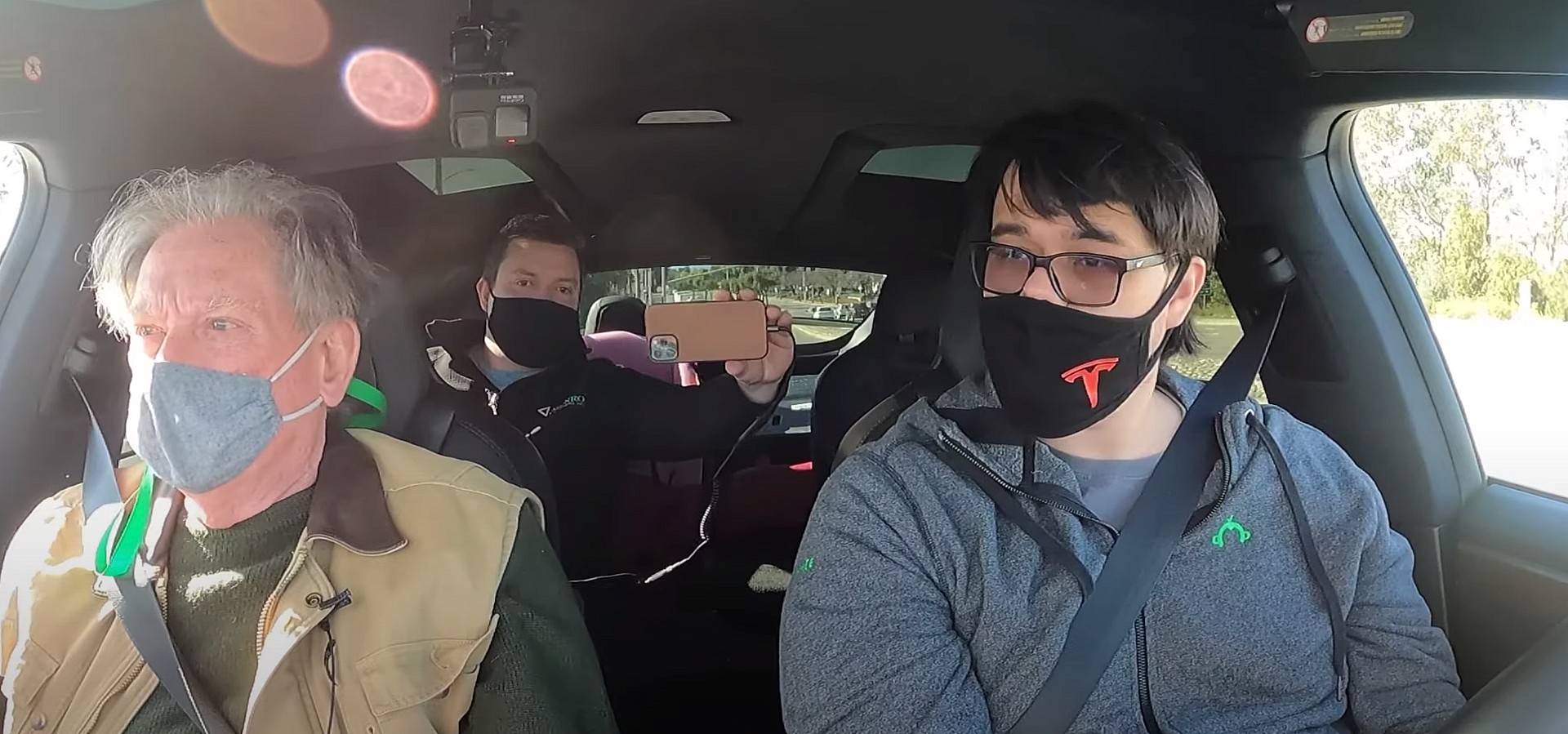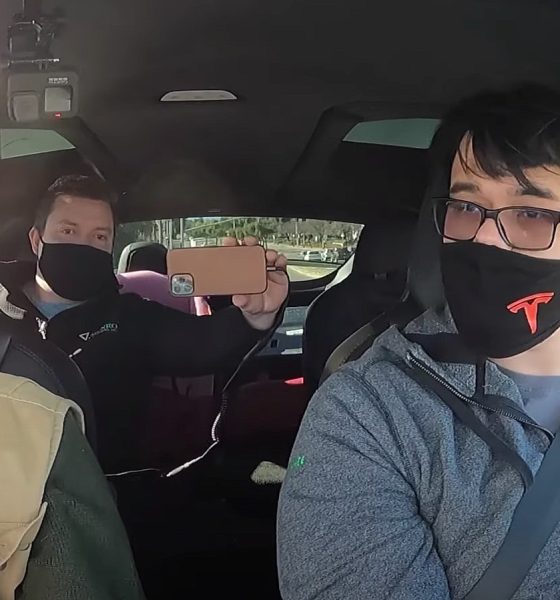

News
Tesla FSD Beta helps Sandy Munro change tune on self-driving
Tesla’s Full Self-Driving Beta has won over automotive industry legend Sandy Munro, who had his first experience with the semi-autonomous characteristic earlier this week with notorious ownership club Tesla Owners Silicon Valley. Munro had one prior experience with Tesla’s self-driving programs, and it wasn’t a pleasant one. However, his first experience with FSD Beta quickly changed Munro’s tune, where he commended the program during a short drive through Northern California.
John of Tesla Owners Silicon Valley had the unique opportunity to show Munro, accompanied by colleague Cory Steuben, the improvements that Tesla had made with the Full Self-Driving suite. A long-time veteran of the industry, Munro has seen numerous driver assistance programs through the years, but none as complex as Tesla’s. The company’s FSD suite is packed with intricate coding to identify objects, a constantly-working Neural Network responsible for gathering information based on driver interaction and behavior, and an always-improving infrastructure thanks to the Neural Net and drivers who utilize the semi-autonomous functionality.
Tesla’s Full Self-Driving suite has been around for several years, but its most significant development was the FSD Beta program’s release in October 2020. Elon Musk announced that a small group of Beta testers would have access to the capability and would hold the responsibility of testing the accuracy and maneuverability of Full Self-Driving in public driving situations.
Through the FSD Beta program, 11 builds have been released, building upon the previous version with more robust features and more accurate navigation without much intervention from the driver.
Luckily, John has been with the Beta program since day 1 and is a constant contributor to the information Tesla receives. Fortunately, this also meant that Sandy Munro was experiencing the most complex self-driving program on Eaarth, giving him a full-fledge sneak peek into what will be available across the board soon.
Tesla, teardowns, and treats: Sandy Munro talks 2,300-mile journey across the U.S.
While Elon Musk has not announced a specific date for the FSD suite’s full release, the Beta program has been expanded to 1,000 members. Musk is consistent with his predictions that a Level 5 autonomous vehicle will be released by Tesla by the end of the year.
He commented on this during the Q4 2020 Earnings Call:
“I guess I’m confident based on my understanding of the technical roadmap and the progress that we’re making between each beta iteration. Yes. As I’m saying, it’s not remarkable at all for the car to completely drive you from one location to another through a series of complex intersections. It’s now about just improving the corner case reliability and getting it to 99.9999% reliable with respect to an accident. Basically, we need to get it to better than human bio factor at least 100% or 200%. And the business is happening rapidly because we’ve got so much training data with all the cars in the field. And the software is improving dramatically. The — we also write the software for labeling…So I think there could be a whole line of business in and of itself. And then, of course, for training vast amounts video data and getting the reliability from 100% to 200% better than average human to 2,000% better than average human. So that will be very helpful in that regard.”
Check out Tesla Owners Silicon Valley‘s video of Sandy Munro experiencing the FSD Beta below.

News
Tesla FSD fleet is nearing 7 billion total miles, including 2.5 billion city miles
As can be seen on Tesla’s official FSD webpage, vehicles equipped with the system have now navigated over 6.99 billion miles.

Tesla’s Full Self-Driving (Supervised) fleet is closing in on almost 7 billion total miles driven, as per data posted by the company on its official FSD webpage.
These figures hint at the massive scale of data fueling Tesla’s rapid FSD improvements, which have been quite notable as of late.
FSD mileage milestones
As can be seen on Tesla’s official FSD webpage, vehicles equipped with the system have now navigated over 6.99 billion miles. Tesla owner and avid FSD tester Whole Mars Catalog also shared a screenshot indicating that from the nearly 7 billion miles traveled by the FSD fleet, more than 2.5 billion miles were driven inside cities.
City miles are particularly valuable for complex urban scenarios like unprotected turns, pedestrian interactions, and traffic lights. This is also the difference-maker for FSD, as only complex solutions, such as Waymo’s self-driving taxis, operate similarly on inner-city streets. And even then, incidents such as the San Francisco blackouts have proven challenging for sensor-rich vehicles like Waymos.
Tesla’s data edge
Tesla has a number of advantages in the autonomous vehicle sector, one of which is the size of its fleet and the number of vehicles training FSD on real-world roads. Tesla’s nearly 7 billion FSD miles then allow the company to roll out updates that make its vehicles behave like they are being driven by experienced drivers, even if they are operating on their own.
So notable are Tesla’s improvements to FSD that NVIDIA Director of Robotics Jim Fan, after experiencing FSD v14, noted that the system is the first AI that passes what he described as a “Physical Turing Test.”
“Despite knowing exactly how robot learning works, I still find it magical watching the steering wheel turn by itself. First it feels surreal, next it becomes routine. Then, like the smartphone, taking it away actively hurts. This is how humanity gets rewired and glued to god-like technologies,” Fan wrote in a post on X.
News
Tesla starts showing how FSD will change lives in Europe
Local officials tested the system on narrow country roads and were impressed by FSD’s smooth, human-like driving, with some calling the service a game-changer for everyday life in areas that are far from urban centers.

Tesla has launched Europe’s first public shuttle service using Full Self-Driving (Supervised) in the rural Eifelkreis Bitburg-Prüm region of Germany, demonstrating how the technology can restore independence and mobility for people who struggle with limited transport options.
Local officials tested the system on narrow country roads and were impressed by FSD’s smooth, human-like driving, with some calling the service a game-changer for everyday life in areas that are far from urban centers.
Officials see real impact on rural residents
Arzfeld Mayor Johannes Kuhl and District Administrator Andreas Kruppert personally tested the Tesla shuttle service. This allowed them to see just how well FSD navigated winding lanes and rural roads confidently. Kruppert said, “Autonomous driving sounds like science fiction to many, but we simply see here that it works totally well in rural regions too.” Kuhl, for his part, also noted that FSD “feels like a very experienced driver.”
The pilot complements the area’s “Citizen Bus” program, which provides on-demand rides for elderly residents who can no longer drive themselves. Tesla Europe shared a video of a demonstration of the service, highlighting how FSD gives people their freedom back, even in places where public transport is not as prevalent.
What the Ministry for Economic Affairs and Transport says
Rhineland-Palatinate’s Minister Daniela Schmitt supported the project, praising the collaboration that made this “first of its kind in Europe” possible. As per the ministry, the rural rollout for the service shows FSD’s potential beyond major cities, and it delivers tangible benefits like grocery runs, doctor visits, and social connections for isolated residents.
“Reliable and flexible mobility is especially vital in rural areas. With the launch of a shuttle service using self-driving vehicles (FSD supervised) by Tesla in the Eifelkreis Bitburg-Prüm, an innovative pilot project is now getting underway that complements local community bus services. It is the first project of its kind in Europe.
“The result is a real gain for rural mobility: greater accessibility, more flexibility and tangible benefits for everyday life. A strong signal for innovation, cooperation and future-oriented mobility beyond urban centers,” the ministry wrote in a LinkedIn post.
News
Tesla China quietly posts Robotaxi-related job listing
Tesla China is currently seeking a Low Voltage Electrical Engineer to work on circuit board design for the company’s autonomous vehicles.

Tesla has posted a new job listing in Shanghai explicitly tied to its Robotaxi program, fueling speculation that the company is preparing to launch its dedicated autonomous ride-hailing service in China.
As noted in the listing, Tesla China is currently seeking a Low Voltage Electrical Engineer to work on circuit board design for the company’s autonomous vehicles.
Robotaxi-specific role
The listing, which was shared on social media platform X by industry watcher @tslaming, suggested that Tesla China is looking to fill the role urgently. The job listing itself specifically mentions that the person hired for the role will be working on the Low Voltage Hardware team, which would design the circuit boards that would serve as the nervous system of the Robotaxi.
Key tasks for the role, as indicated in the job listing, include collaboration with PCB layout, firmware, mechanical, program management, and validation teams, among other responsibilities. The role is based in Shanghai.
China Robotaxi launch
China represents a massive potential market for robotaxis, with its dense urban centers and supportive policies in select cities. Tesla has limited permission to roll out FSD in the country, though despite this, its vehicles have been hailed as among the best in the market when it comes to autonomous features. So far, at least, it appears that China supports Tesla’s FSD and Robotaxi rollout.
This was hinted at in November, when Tesla brought the Cybercab to the 8th China International Import Expo (CIIE) in Shanghai, marking the first time that the autonomous two-seater was brought to the Asia-Pacific region. The vehicle, despite not having a release date in China, received a significant amount of interest among the event’s attendees.








